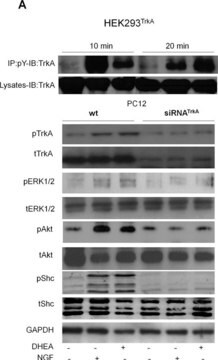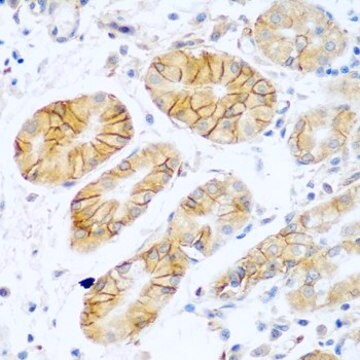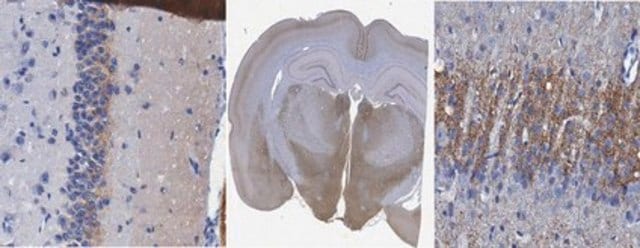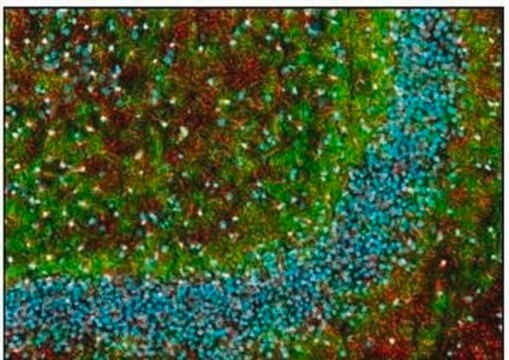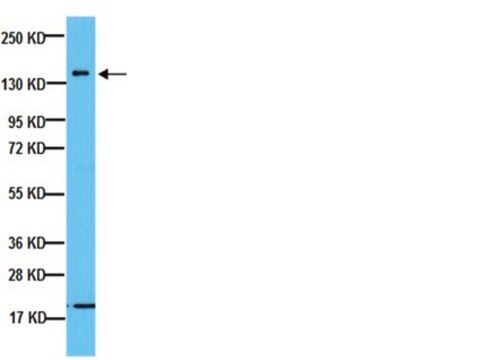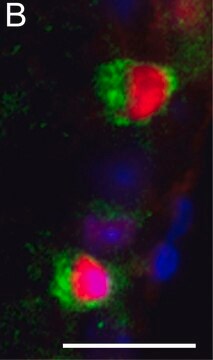MABF959
Anti-CD47 Antibody, clone C5/D5
clone C5/D5, from mouse
Synonyme(s) :
Leukocyte surface antigen CD47, Antigenic surface determinant protein OA3, CD47, IAP, Integrin-associated protein, Protein MER6
About This Item
Produits recommandés
Source biologique
mouse
Niveau de qualité
Forme d'anticorps
purified immunoglobulin
Type de produit anticorps
primary antibodies
Clone
C5/D5, monoclonal
Espèces réactives
human
Technique(s)
flow cytometry: suitable
Isotype
IgG1κ
Numéro d'accès NCBI
Numéro d'accès UniProt
Conditions d'expédition
ambient
Modification post-traductionnelle de la cible
unmodified
Informations sur le gène
human ... CD47(961)
Catégories apparentées
Description générale
Spécificité
Immunogène
Application
Flow Cytometry Analysis: A representative lot detected the expression of exogenously transfected human CD47 on the surface of CaCO2 cells (Liu, Y., et al. (2001). J. Biol. Chem. 276(43):40156-40166).
Flow Cytometry Analysis: Representative lots detected human polymorphonuclear (PMN) neutrophils surface CD47 immunoreactivity, which was upregulated after fMLP stimulation (Liu, Y., et al. (2001). J. Biol. Chem. 276(43):40156-40166; Parkos, C.A., et al. (1996). J. Cell Biol. 132(3):437-450).
Immunoaffinity Purification: A representative lot was immobilized on resins and employed for affinity purification of CD47 from HT29 (subclone Cl 19.A) lysate (Parkos, C.A., et al. (1996). J. Cell Biol. 132(3):437-450).
Immunocytochemistry Analysis: A representative lot immunostained the basolateral surfaces of methanol-fixed CaCO2 monolayers expressing exogenously transfected human CD47 by fluorescent immunocytochemistry (Liu, Y., et al. (2001). J. Biol. Chem. 276(43):40156-40166).
Immunocytochemistry Analysis: A representative lot immunostained the basolateral membrane of paraformaldehyde-fixed T84 human intestinal epithelial cell monolayer by fluorescent immunocytochemistry (Parkos, C.A., et al. (1996). J. Cell Biol. 132(3):437-450).
Immunofluorescence Analysis: A representative lot immunostained the colonic crypts and lamina propria leukocytes at the basal and lateral, but not apical, aspects of the epithelium in paraformaldehyde-fixed frozen human colon tissue sections by fluorescent immunohistochemistry (Parkos, C.A., et al. (1996). J. Cell Biol. 132(3):437-450).
Immunoprecipitation Analysis: A representative lot immunoprecipitated ~60-65 kDa glycosylated CD47 from T84 human intestinal epithelial cell lysate. Target band size reduced to ~35 kDa following deglycosylation by N glycosidase F treatment (Parkos, C.A., et al. (1996). J. Cell Biol. 132(3):437-450).
Neutralizing Analysis: Representative lots caused a delay of human polymorphonuclear (PMN) neutrophils migration across polarized monolayers of T84 human intestinal epithelial cells in a bidirectional fashion without affecting PMN neutrophils or T84 adhesion. Tyrosine phosphorylation inhibitor genistein prevented delay by clone C5/D5 (Liu, Y., et al. (2001). J. Biol. Chem. 276(43):40156-40166; Parkos, C.A., et al. (1996). J. Cell Biol. 132(3):437-450).
Inflammation & Immunology
Qualité
Flow Cytometry Analysis: 0.4 µL of this antibody detected CD47 surface expression on the gated lymphocytes population among one million human PBMCs.
Description de la cible
Forme physique
Stockage et stabilité
Handling Recommendations: Upon receipt and prior to removing the cap, centrifuge the vial and gently mix the solution. Aliquot into microcentrifuge tubes and store at -20°C. Avoid repeated freeze/thaw cycles, which may damage IgG and affect product performance.
Autres remarques
Clause de non-responsabilité
Vous ne trouvez pas le bon produit ?
Essayez notre Outil de sélection de produits.
Code de la classe de stockage
12 - Non Combustible Liquids
Classe de danger pour l'eau (WGK)
WGK 2
Point d'éclair (°F)
Not applicable
Point d'éclair (°C)
Not applicable
Certificats d'analyse (COA)
Recherchez un Certificats d'analyse (COA) en saisissant le numéro de lot du produit. Les numéros de lot figurent sur l'étiquette du produit après les mots "Lot" ou "Batch".
Déjà en possession de ce produit ?
Retrouvez la documentation relative aux produits que vous avez récemment achetés dans la Bibliothèque de documents.
Notre équipe de scientifiques dispose d'une expérience dans tous les secteurs de la recherche, notamment en sciences de la vie, science des matériaux, synthèse chimique, chromatographie, analyse et dans de nombreux autres domaines..
Contacter notre Service technique